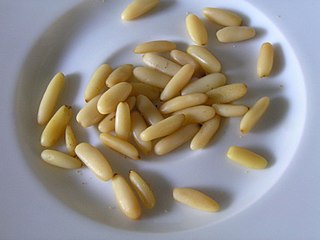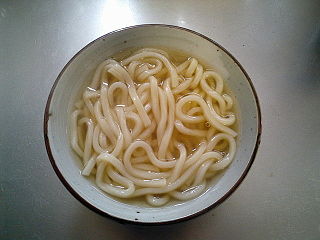
Udon is a type of thick wheat flour noodle used frequently in Japanese cuisine. It is often served hot as a noodle soup in its simplest form, as kake udon, in a mildly flavoured broth called kakejiru, which is made of dashi, soy sauce, and mirin. It is usually topped with thinly chopped scallions. Other common toppings include tempura, often prawn or kakiage, or aburaage, a type of deep-fried tofu pockets seasoned with sugar, mirin, and soy sauce. A thin slice of kamaboko, a halfmoon-shaped fish cake, is often added. Shichimi can be added to taste.
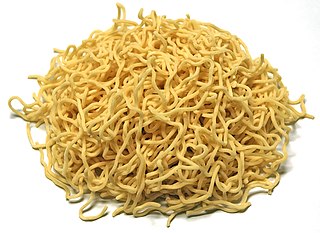
Noodles are a staple part of Japanese cuisine. They are often served chilled with dipping sauces, or in soups or hot dishes.

Naengmyeon or raengmyŏn is a Korean noodle dish of long and thin handmade noodles made from the flour and starch of various ingredients, including buckwheat, potatoes, sweet potatoes, arrowroot starch, and kudzu. Buckwheat predominates. Other varieties of naengmyeon are made from ingredients such as seaweed and green tea.

Korean royal court cuisine was the style of cookery within Korean cuisine traditionally consumed at the court of the Joseon Dynasty, which ruled Korea from 1392 to 1910. There has been a revival of this cookery style in the 21st century. It is said that twelve dishes should be served along with rice and soup, with most dishes served in bangjja (bronzeware).

Mak-guksu (막국수) or buckwheat noodles is a Korean buckwheat noodle dish served in a chilled broth and sometimes with sugar, mustard, sesame oil or vinegar. It is a local specialty of the Gangwon province of South Korea, and its capital city, Chuncheon.

Noodle soup refers to a variety of soups with noodles and other ingredients served in a light broth. Noodle soup is common dish across East and Southeast Asia. Various types of noodles are used, such as rice noodles, wheat noodles and egg noodles.

Kal-guksu is a Korean noodle dish consisting of handmade, knife-cut wheat flour noodles served in a large bowl with broth and other ingredients. It is traditionally considered a seasonal food, consumed most often in summer. Its name comes from the fact that the noodles are not extruded or spun, but cut.
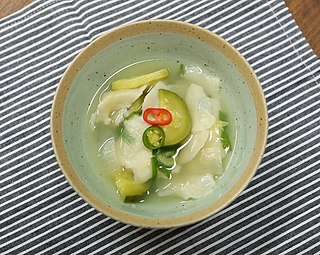
Sujebi, ttŭdŏ-guk, or hand-pulled dough soup is a Korean traditional soup consisting of dough flakes roughly torn by hand, with various vegetables. The flavor and recipe resemble kalguksu, except that the latter is made with noodles rather than wheat flakes. It is commonly considered a dish to consume on rainy days, along with bindaetteok.

Bibim-guksu (비빔국수) or spicy noodles, a cold dish made with very thin wheat flour noodles called somyeon with added flavorings, is one of the most popular traditional noodle dishes in Korean cuisine and especially popular during summer.

Janchi-guksu or banquet noodles is a Korean noodle dish consisting of wheat flour noodles in a light broth made from anchovy and sometimes also dasima (kelp). Beef broth may be substituted for the anchovy broth. It is served with a sauce made from sesame oil, ganjang and small amounts of chili pepper powder and scallions. Thinly sliced jidan, gim (laver) and zucchini are added on top of the dish as garnishes.
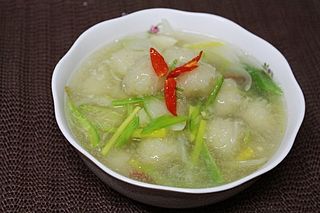
Gamja-ongsimi (감자옹심이) or potato dough soup is a variety of sujebi in Korea's Gangwon cuisine. Both the potato dumplings and the soup, together can be referred to as gamja-ongsimi. The juk (porridge) made with potato balls as its ingredient is called gamja-ongsimi-juk, and the kal-guksu made with the potato balls is called gamja-ongsimi-kal-guksu.
Korean regional cuisines are characterized by local specialties and distinctive styles within Korean cuisine. The divisions reflected historical boundaries of the provinces where these food and culinary traditions were preserved until modern times.

In Korean cuisine, garak-guksu (가락국수) are thick wheat noodles and noodle dishes made with thick noodles.

Milmyeon is a Korean dish of long and thin noodles similar to naengmyeon, representing the dishes of Busan. The noodle is basically mixing flour powder with starches of sweet potato and potato with meat broth, which bring it and water, several kinds of vegetables to a simmer in saucepan. The mixture of flour is not fixed at certain ingredients, leading to several transformation like using Artemisia princeps for ssuk milmyeon. Milmyeon also has its variety of mul milmyeon and bibim milmyeon applicable for naengmyeon. The difference between the two is chiefly spicy sauce for bibim milmyeon.

Jungguk-naengmyeon is a type of naengmyeon in Korean Chinese cuisine. The dish, consisting of icy cold broth with noodles, blanched seafood, fresh vegetables, and hard-boiled egg, is usually served with mustard and peanut sauce.


